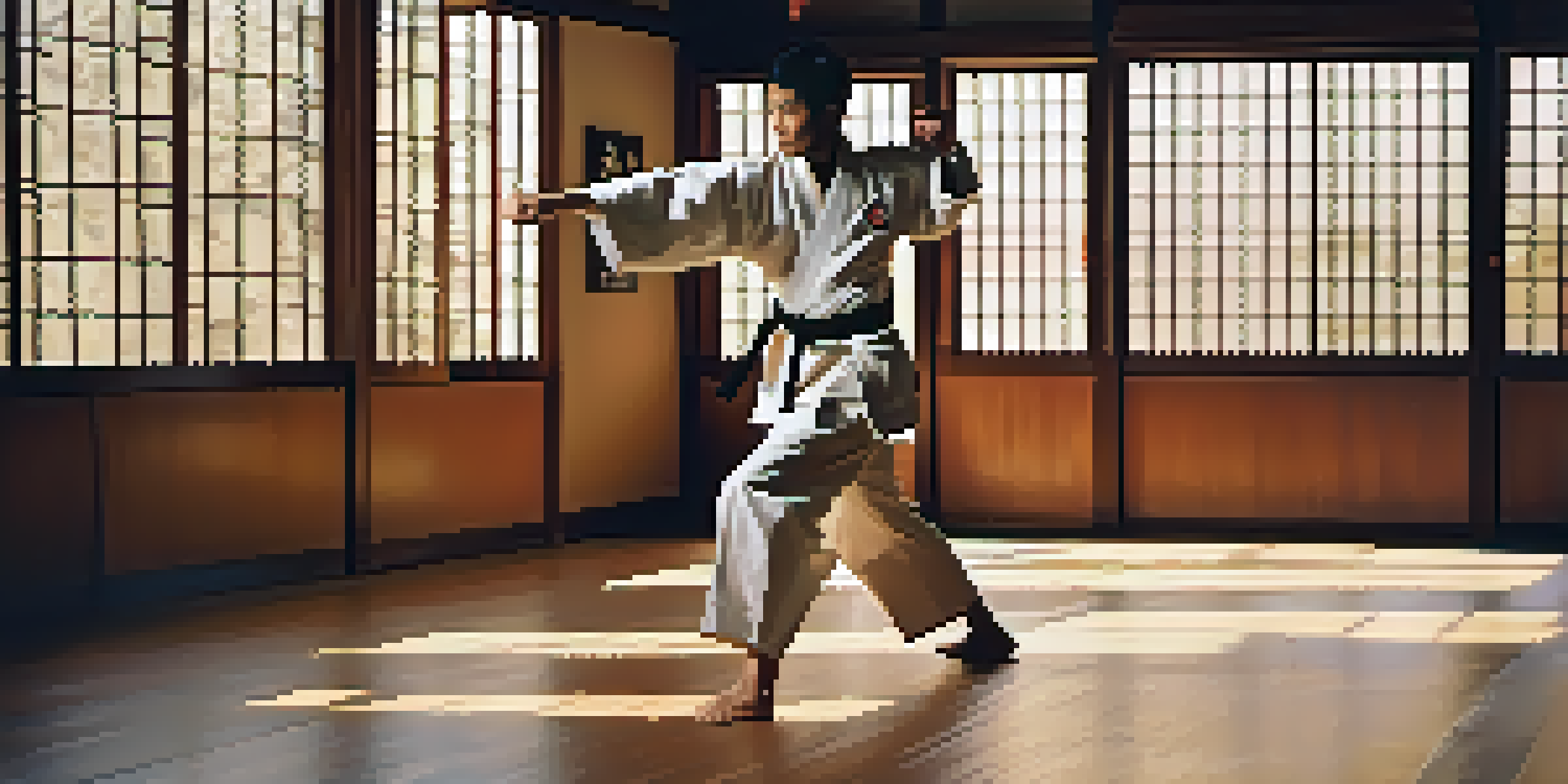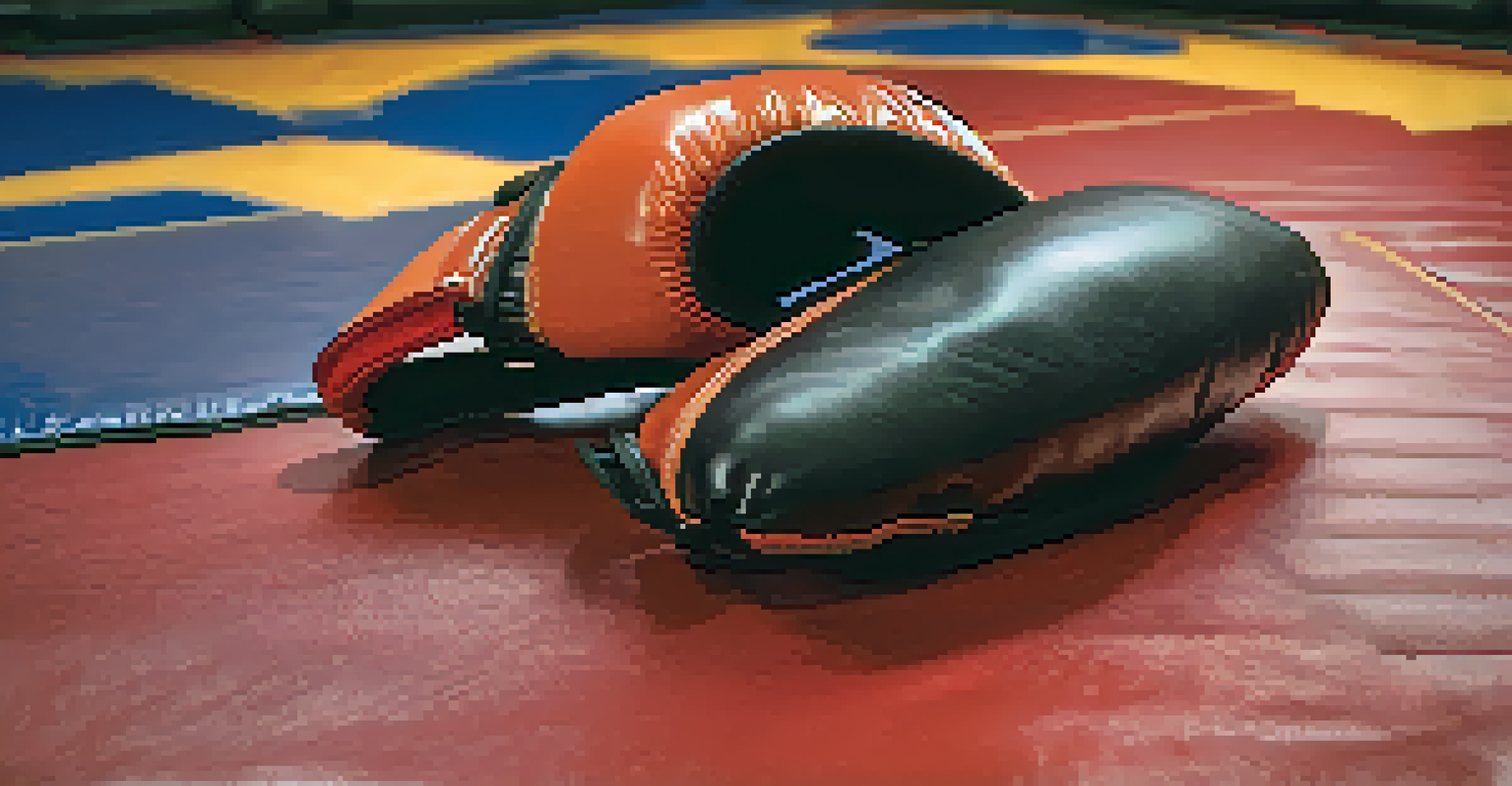Common Injuries in Martial Arts and How to Prevent Them

Understanding Common Martial Arts Injuries
Martial arts can be a thrilling way to enhance physical fitness and discipline, but injuries can occur. Common injuries include sprains, strains, and fractures, often resulting from improper techniques or lack of conditioning. Additionally, injuries such as bruises and cuts are frequent due to the contact nature of many martial arts styles. Recognizing these injuries is the first step in prevention.
The body achieves what the mind believes.
For example, a sprained ankle may happen during a kick or a fall, while a wrist injury can occur from blocking an opponent's strike. The more aware you are of these potential injuries, the better prepared you'll be to avoid them. Understanding the types of injuries prevalent in martial arts also helps in tailoring your training and safety measures.
Ultimately, awareness is key. By being informed about common injuries, martial artists can implement strategies to reduce their risk and enjoy their practice safely.
The Importance of Proper Warm-Up Techniques
A thorough warm-up is essential before any martial arts training session. Warming up increases blood flow to the muscles and prepares your body for the physical demands of practice. A proper warm-up routine might include dynamic stretches, light cardio, and mobility drills, which can help prevent injuries like strains and sprains.

Think of warming up as preparing a car for a long drive; you wouldn’t start a journey without checking the oil and tires first. Similarly, ensuring your muscles and joints are ready can make a significant difference in performance and safety. By dedicating time to warm up, you will enhance your flexibility and reduce the likelihood of injury.
Injury Awareness is Crucial
Understanding common martial arts injuries helps practitioners implement effective prevention strategies.
Incorporating a consistent warm-up routine into your training can also improve overall performance. As your body adapts to the exercises, you’ll notice increased strength and agility, making your martial arts practice even more enjoyable.
Strengthening Core Muscles for Better Stability
A strong core is fundamental in martial arts, providing stability and balance during movements. Core muscles support your spine and help maintain proper posture, which can prevent injuries like lower back pain or strains. Exercises like planks, leg raises, and Russian twists can effectively strengthen your core.
In the middle of every difficulty lies opportunity.
Imagine your core as the trunk of a tree; a sturdy trunk supports the branches and leaves. Similarly, a strong core supports your limbs during kicks, punches, and falls. By focusing on core strength, you'll improve your overall performance while reducing the risk of injury.
Moreover, a well-conditioned core allows for more powerful strikes and better control during sparring. By integrating core-strengthening exercises into your routine, you’ll not only protect yourself but also enhance your martial arts skills.
Using Proper Gear and Equipment for Protection
Wearing the appropriate gear is crucial in preventing injuries during martial arts training. Items like mouthguards, gloves, shin guards, and headgear can significantly reduce the risk of cuts, bruises, and more severe injuries. Ensuring that your equipment fits well and is in good condition can make a huge difference.
For instance, a well-fitted mouthguard can protect your teeth and jaw from impact during sparring. Just as a football player wouldn’t hit the field without a helmet, martial artists should always train with proper protective gear. This not only enhances safety but also helps build confidence during practice.
Warm-Up to Prevent Injuries
A proper warm-up routine enhances muscle readiness and significantly reduces the risk of injuries during training.
In addition, regularly checking your gear for wear and tear is vital. If equipment is damaged, it can fail to provide the necessary protection, leaving you vulnerable to injury.
Practicing Techniques with Proper Form
Proper technique is essential in martial arts to prevent injuries. Practicing moves with the correct form not only maximizes effectiveness but also minimizes strain on your body. Whether it’s a kick, punch, or throw, focusing on form can help you avoid common injuries associated with improper movements.
Imagine trying to lift a heavy weight without the right posture; the risk of injury is high. Similarly, a poorly executed martial arts technique can lead to sprains or strains. Consistent practice with proper form is vital to ensure you’re training safely and effectively.
Additionally, consider working with a qualified instructor who can provide feedback on your techniques. Regularly reviewing and refining your form will help you develop good habits and protect yourself in the long run.
Listening to Your Body: The Key to Injury Prevention
One of the most effective ways to prevent injuries in martial arts is to listen to your body. If you feel pain, fatigue, or discomfort, it's crucial to acknowledge it and adjust your training accordingly. Pushing through pain can lead to more severe injuries and setbacks in your progress.
Think of your body as a finely tuned instrument; if something feels off, it’s essential to make adjustments. Taking breaks when necessary, allowing time for recovery, and not training through pain are vital for long-term success. Remember, it's okay to take a step back to prevent a bigger problem down the line.
Listen to Your Body
Paying attention to your body's signals is key to preventing injuries and ensuring long-term success in martial arts.
Moreover, incorporating rest days into your training schedule can aid recovery and help prevent overuse injuries. By being mindful of your body's signals, you’ll be able to train more effectively and enjoy martial arts without the fear of injury.
The Role of Cross-Training in Injury Prevention
Cross-training can be an excellent strategy for preventing injuries in martial arts. By engaging in different forms of exercise, you can improve overall fitness and reduce the risk of overuse injuries. Activities like swimming, yoga, or strength training can complement your martial arts practice and enhance your physical capabilities.
Just like a well-balanced diet improves your health, a varied workout routine boosts your fitness levels. Cross-training helps develop different muscle groups and can improve flexibility, strength, and endurance. These benefits translate directly into better performance during martial arts training.

Additionally, cross-training can provide a mental break from the intensity of martial arts practice. This variety can help keep your training fresh and engaging while ensuring your body stays in top shape.
The Importance of Recovery and Rehabilitation
Recovery is just as important as training when it comes to preventing injuries in martial arts. After an intense practice or competition, your body needs time to heal and rebuild. Incorporating recovery techniques like stretching, foam rolling, and adequate sleep can significantly enhance your recovery process.
Think of recovery as the reboot of your computer; taking time to restore your system keeps everything running smoothly. Ignoring recovery can lead to fatigue and increased risk of injury, so it's essential to prioritize it in your training routine. Listening to your body and recognizing when you need rest is vital for long-term success.
Moreover, if injuries do occur, seeking proper rehabilitation is crucial. Working with a physical therapist or sports medicine professional can help ensure a safe return to training, minimizing the risk of re-injury.